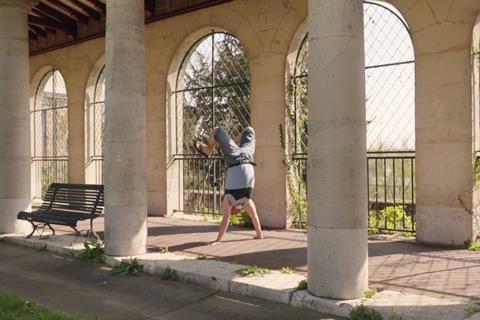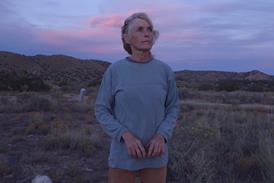Nicolas Philibert profiles two Parisian psychiatric units in the second of a planned trilogy following ’On The Adamant’

Dir. Nicolas Philbert. France 2024. 143mins
Vetern documentarian Nicolas Philibert brings his focus to the Esquirol Hospital in Saint-Maurice near Paris; in particular, two psychiatric units named after the Islamic philosopher and mathematician Avveroes and American civil rights icon Rosa Parks. The second in a projected trilogy following last year’s On The Adamant, it is a more austere film, its energies much more introverted – with contents that, at times, are altogether harrowing.
An extremely accomplished and compelling work
On The Adamant deservedly won Berlin’s Golden Bear, surely in part because the film was so uplifting: an affirmative, compassionate depiction of a Parisian mental health facility and its patience. Celebrating an enlightened, culture-based approach to psychiatric care, On the Adamant was in the best sense – if such a thing is imaginable – a feelgood film about mental illness. At Averroès & Rosa Parks, which premiered in Berlinale Special, is a tougher watch than its predecessor, but an extremely accomplished and compelling work, the latest chapter in a formidable documentary career that includes such works as Etre Et Avoir and 1997 psychiatric clinic study Every Little Thing.
The film begins with a panoramic drone shot scanning the grid-like construction of the vast building, with a staff member watching the footage and noting that, like so many French institutional buildings of the period, it resembles a prison; indeed the edifice, originally built in the 18th century, dates from a time when mental institutions were indeed more akin to prisons.
Where On The Adamant highlighted the collective cultural activities of a day centre on the Seine, this sequel largely comprises a set of consultations between staff members and resident patients (some of whom are soon to be discharged, and who are advised by doctors to use the resources of the Adamant). Philbert’s unobtrusive camera typically keeps to a shot-reverse-shot pattern in medium, with the occasional close-up; one sequence has a woman apparently talking to someone behind the camera, but the film largely maintains its observational detachment, listening in on the patients’ accounts of their experiences, and the doctors’ questions and comments.
If On The Adamant came across as a set of fascinating character studies, the detachment of its sequel offers more of an inventory of varieties of mental illness. The dialogues between patients and carers – who come across as eminently empathetic, albeit to varying degrees – reveal the kind of stresses and challenges faced by mentally ill people both in the wider world and within the psychiatric system into which they are often painfully aware of having been absorbed.
Among the people we meet are Monsieur Obadia, about to be discharged, who is being offered temporary shared accommodation in the city, but whose concerns – about his own religious observation as a Jew, and about the French government with its policy of secularity – leads him to counter every suggestion with anxious objections. Then there is Olivier, a young man with learning difficulties, who is confused about his family relations, convinced that other people’s daughters are his and that his dead father and grandfather are present at the hospital in the form of other people (although at the same time, he seems fully aware of everyone’s real identity).
If there is an individual in this film who particularly fascinates, it is middle-aged Noé, first glimpsed making brief comments in a handful of group discussion scenes. Towards the end of the film, Noé has an individual meeting with two staff members and explains his history as a Jewish Buddhist, an idealistic higher education teacher suffering from burnout, a dissenter from the French academic system, and a self-confessed “megalomaniac” and “metapsychic chameleon” who identifies very closely with the thinkers he reads (“I became Nietszche”). Not that this is Philibert’s intention, but Noé, like several regulars on the Adamant, could easily have been subjects of entire features.
While the extended Noé sequence might have made an uplifting conclusion – showing mental illness in a particularly vibrant and, it seems, creative form – Philibert refuses us obvious consolations by following it with the second of two sequences with a profoundly troubled, angry elderly woman named Laurence. This give the film a decidedly different inflection, revealing the extremes of mental suffering in a bleakly realistic fashion. These sequences, however, also raise thorny questions of consent and intrusiveness; similar issues were raised back in 1967 by another mental institution documentary, the controversial Titicut Follies, by Philibert’s kindred spirit Frederick Wiseman.
As well as the odd briefly-shown group meeting and activity, punctuating shots show the corridors and courtyards of the Esquirol Hospital, including the monastic-looking cloisters that are traces of the building’s less enlightened early days. Aalthough this is never commented on, the hospital was formerly known as the Charenton asylum, in its day housing such eminent patients as the poet Verlaine and the Marquis de Sade.
Production companies: TS Productions
International sales: Les Films du Losange sales@filmsdulosange.fr
Producers: Miléna Poylo, Gilles Sacuto, Céline Loiseau
Cinematography: Nicolas Philbert
Editors: Nicolas Philbert, Janusz Baranek
























